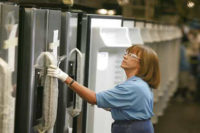SAN JOSE, CA—The Autonomous Vehicle Computing Consortium Inc. (AVCC), a global collaboration of automotive and technology industry leaders focused on automated and assisted driving compute solutions, has released two new technical reports. They provide the basis for a common autonomous vehicle language and conceptual system architecture, as well as use cases for automated and assisted driving systems.
The documents are TR-001 (Conceptual Architecture for Automated and Assisted Driving Systems) and TR-002 (Functional Guide to Image Signal Processing).
"The path to a truly autonomous future is paved with foundational technology and computing challenges requiring industry collaboration," says Paul Hughes, chair of the AVCC Technical Committee and lead system architect and distinguished engineer at Arm Ltd. "The new technology reports are a result of key industry players working together to establish a common language and frame of reference for critical autonomous applications, taking us a step closer to a safe, truly autonomous future."
TR-001 focuses on the AVCC conceptual system architecture for automated and assisted driving compute systems. It is designed to align with the SAE International 1-5 levels of driving automation. Topics go beyond a functional block diagram to cover underlying compute elements, example workloads and related industry standards. This includes compute functions, data marshalling, connectivity (internal and external), module interoperability, availability and power metrics.
"This paper essentially is a guide to understand the AV compute system architecture, its information flow and our terminology," explains Volker Hampel, chair of the AVCC System Architecture Working Group and group head of IC solutions base development at Continental AG. "The functional block diagram is a great tool to foster better communication and expedite innovation."
TR-002 provides established industry practices and use cases for image signal processing (ISP) to help expedite industry growth of automated and assisted driving vehicles. Contents are limited to the ISP domain, which starts at the output of the imaging sensors to the output of the preprocessing blocks.
Topics include the conceptual ISP architecture highlighting operation, image format, KPIs, precision and throughput, as well as real-time imaging.
"This document highlights the tools we have to process images and data which should help facilitate industry growth," notes Jonas Hammarstrom, chair of the AVCC Imaging Working Group and director of pre-development vision at Veoneer Inc. "The workflows, operation recommendations and benchmarks offer a great guide to understanding the various enhancement modules and options within ISP systems."
To learn more about the technical reports, click here.


